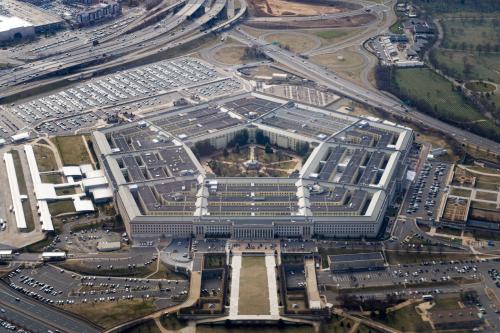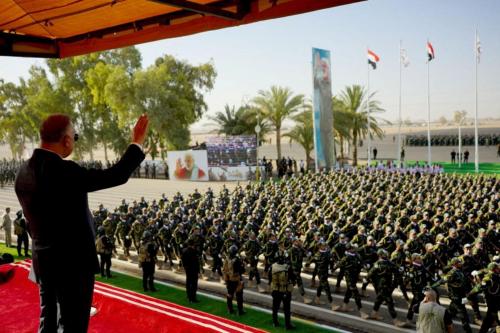Content from the Brookings Doha Center is now archived. In September 2021, after 14 years of impactful partnership, Brookings and the Brookings Doha Center announced that they were ending their affiliation. The Brookings Doha Center is now the Middle East Council on Global Affairs, a separate public policy institution based in Qatar.
A new and dangerous front appears to have opened in Syria. Since early January 3, members of three militant fronts — the largely nationalist Syrian Revolutionaries Front; the moderately Islamist Jaish al-Mujahideen; and the Salafist Islamic Front (IF) — have engaged in sustained clashes with the extremist Islamic State in Iraq and al-Sham (ISIS). Fighting began in Idlib province and has since spread throughout Aleppo province and into the city of Raqqa, the governorate capital under opposition control and a key ISIS stronghold. So far, activist and militant group reports suggest hostilities have affected at least 40 separate municipalities, with ISIS having lost control of as many as 24.
While ISIS appears to have been incurring strategic withdrawals rather than outright military defeats, its chief spokesman announced on January 7 that all individuals and groups linked to the Western-backed Syrian National Coalition (SNC) and the Syrian Military Council (SMC) were now legitimate targets, effectively amounting to a declaration of war.
ISIS, whose roots lie originally in Iraq’s al Qaeda insurgency, first began operations in Syria in April and May 2013. In the eight months since then, it has enjoyed a meteoric rise to prominence. At least 35 municipalities were under total or partial control of ISIS and the group had established areas of operation in 10 of Syria’s 14 governorates by January 1. In Iraq, ISIS grew exponentially throughout 2013, inflicting a level of violence not seen in that country since 2008. The group is currently in de facto control of several urban areas in eastern Anbar province. On January 4, ISIS claimed to have expanded its operations into Lebanon via its purported assumption of responsibility for the January 2 car bombing in southern Beirut, which killed four people and wounded 77. In so doing, ISIS truly did justice to its name — incorporating Iraq, Syria, and Lebanon into its sphere of influence.
At first glance, a sustained pushback against ISIS might appear to be an encouraging development, and indeed, in some respects it certainly is. After all, this is the first time a broad spectrum of Syrian anti-government militant groups have confronted ISIS’s territorial control with such apparent determination. Several ISIS members I have spoken to went as far as to claim Western intelligence had facilitated the attacks by jamming local radio frequencies known to be used by ISIS — although no evidence exists to substantiate these claims.
Whether this latest offensive was pre-planned or simply opportunistic, ISIS’s offensive reaction has so far been relatively minimal, at least in terms of what it is potentially capable. Its threat on the evening of January 4 to pull its forces out of 18 active battlefronts in Aleppo in order to launch a counter-attack against Jaish al-Mujahideen, the SRF, and the IF should be borne in mind.
The conflict in Syria has afforded ISIS with an invaluable opportunity to establish a concrete foothold in the heart of the Middle East and, so far, it has done exactly that. Moreover, it’s had the last eight months to consolidate its gains. While it has undoubtedly lost out territorially over the past 96 hours, it has both the manpower and the military capability to existentially damage the capacity of opposition forces to effectively confront the Syrian government.
Following its establishment in Iraq’s Anbar province in 2005, the much publicized Sahwa — or Sunni tribal Awakening Council movement — may have largely succeeded in forcing the predecessor of ISIS, the Islamic State in Iraq (ISI) out of most key urban centers. But it very quickly became a target itself. To this day, Awakening Council militiamen are still a major target of near-daily ISIS killings, normally in the form of silenced small-arms assassinations and so-called sticky bomb attacks.
Although recent events in Syria do not amount to such a centralized initiative as Iraq’s Awakening Councils, Pandora’s Box may well have been opened. Syrians of all ideological stripes might finally be grasping back a handle hold of their revolution and uniting under that single objective (in and of itself, a very positive development), but for Syria’s long-term future, it is sadly far too late. In turning their weapons against an already well-established force with seemingly solid sources of financial backing and recruits from all corners of the world, Syria’s opposition forces are creating an enemy that will, unfortunately without a doubt, cause considerable instability in Syria for years to come. The January 7 ISIS statement in which anyone suspected of involvement in Syria’s “Sahwa” was declared a legitimate target was telling, especially in its language:
“We have armies in Iraq and an army in Syria full of hungry lions who drink blood and eat bones, finding nothing tastier than the blood of Sahwa.”
All the more, the official al Qaeda affiliate in Syria — Jabhat al-Nusra — arguably stands to gain the most from this current state of affairs. That it has taken control of several previously ISIS-held areas in Idlib and Aleppo and was at least partially involved in the fighting in Raqqa underscores this reality.
ISIS’s recent statement declaring war with the SNC and SMC suggests a troubling and destabilizing time ahead for Western-backed political and military structures. ISIS, and its predecessor in Iraq, has proven to be a highly resolute and resilient organization, capable of evolving in order to survive and later flourish. It has been weakened, no doubt about it, but this is not the end of ISIS in Syria. It retains strong relations with other jihadist groups in Syria, particularly those with a strong muhajideen (or foreign fighter) component, and several localized front groups of Jabhat al-Nusra appear to remain unwilling to militarily confront their fellow Muslim jihadists. While it may take weeks if not months to get going, it seems highly likely that ISIS will gradually initiate a spoiling campaign of sabotage-like assassination and other attack campaigns aimed at individuals, groups, and assets linked to the SNC and SMC.
With pressure already sky high regarding the controversial upcoming Syrian peace conference in Switzerland, there is an overwhelming emphasis from many within the international community to encourage a sense of unity of purpose within Syria’s opposition. Since the fighting against ISIS began on January 3, the Syrian activist and externally-based political opposition structure appears to have received a boost of positive energy. As such, these newly prevalent conditions present a more favorable environment for policymakers to renew a push for unity within the political opposition. And perhaps more importantly, they present a situation in which it is more important than ever to demonstrate real and genuine support to the armed opposition on the ground — not solely limited to the SMC, which is increasingly irrelevant in terms of practical dynamics, but to the crucial power-players currently involved in combating ISIS.
If ISIS is afforded the opportunity to launch a concerted counter-attack while Syria’s opposition remains inherently disunited, one thing is for certain: The conflict in Syria will become even more complex and intractable. ISIS may well be weakened, but the resulting instability could come back to haunt both the region and the West in the years to come.



Commentary
Op-edSyria’s New Rebel Front
January 8, 2014